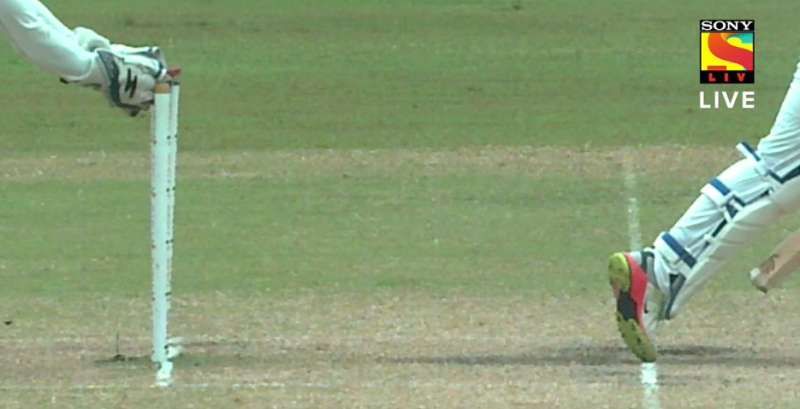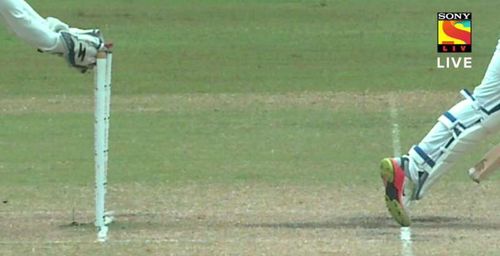
Sri Lanka v Zimbabwe 2017: Appalling decision from the third umpire is the SK Turning point of the match
The only Test match between Sri Lanka and Zimbabawe was poised beautifully at the start of play today. It was the fifth day of the Test, and both the teams were in with a real chance of coming out victorious at the end of the contest. However, it was the Sri Lankan batsmen that managed to hold their nerves in the tricky last sessions of the day. However, it is not just the players that made this victory probable for the hosts:
The turning point of the match came with a shocking decision from the third umpire in the 69th over of the game.
Sikandar Raza was bowling to Niroshan Nickwella, with the latter batting on 37. He had till then smashed Raza all around the park and had picked up eight runs in the first three deliveries of the over. The fourth delivery, however, saw Raza beat his outside edge.
Wicket-keeper Regis Chakabva took no time to take the bails off, and as per usual practice, the on-field umpire went upstairs with the decision. The big screen displayed Dickwella’s back foot on the line, but none of it looked to be behind the crease.
Chettithody Shamshuddin, the third umpire, wanted to be absolutely sure before declaring the batsman to be dismissed though. He saw numerous replays of the potential dismissal and decided to give the benefit of the doubt to the batsman after all that hullabaloo.
However, not an inch of Dickwella’s left shoe seemed to be behind the line. Why wasn’t the man given out then?
This is what the third ump saw?#SLvZIM pic.twitter.com/Fm4XLCs8lK
— Suneer (@suneerchowdhary) July 18, 2017
Lance Klusener, Zimbabwe’s batting coach, was already seen celebrating in the dressing room. Head coach Head Streak, too, made his immediate disbelief apparent. Let us look at the stumping law to understand whether or not the third umpire can justify him going in favour of the batsman in this case.
The rule states that:
If the batsman does not have his bat or any part of his body behind the crease before the bails are whipped off, he is considered out. If the foot is on the crease line itself but not completely across it as well as touching the ground behind it, he is considered to be out. The line belongs to the bowler.
However, the third umpire is entitled to give the benefit of the doubt to the batsman. However, was there enough meat for the doubt to be warranted, in the first place?
Also read: ICC Women's World Cup 2017: What exactly is wrong with Smriti Mandhana?
Tweet speak:
If nothing behind the line then its out but umpire thought other way.. pic.twitter.com/AtBB67IrUM
— Sarcastic Dude (@Sarcasticdudee) July 18, 2017
If the Dickwella decision turns out to hurt Zimbabwe, it's safe to say the 3rd umpire will catch the earliest flight back to home.#SLvZIM
— HoldingWilley (@holdingwilley) July 18, 2017
Crime to give a bad call despite having time and technology. No part of Dickwella's backfoot was inside the crease. Poor, C Shamsuddin.
— Shashank Kishore (@captainshanky) July 18, 2017
Usually the stronger team gets the benefit of doubt. I have seen enough to say that isn't the case.
— Bharath Ramaraj (@Fancricket12) July 18, 2017
I have no idea why the Indian umpires are officiating in Intl. matches.
— Vignesh (@MadridistaSays) July 18, 2017
Zimbabwe are being robbed here #SLvZIM
Yes shit happens when a weak team fights for the victory decisions goes against them.
— Shit Umpiring (@cricdrugs) July 18, 2017
Come on ZIM show them the grit.
Zimbabwe robbed there. Dickwella had nothing behind the line and was stumped. Given not out. #SLvZIM https://t.co/F7QpKRW7W8
— Saurabh Somani (@saurabh_42) July 18, 2017
Come on, that was OUT #SLvZIM
— Gaurav Kalra (@gauravkalra75) July 18, 2017
If the foot is on the line then its out and for me the foot was on the line Dickwella was lucky to survive from that decision...
— Broken Cricket (@BrokenCricket) July 18, 2017
Brainfades have a new meaning. After looking at the replays 20 times, you give that not-out.#SLvZIM
— Suneer (@suneerchowdhary) July 18, 2017
nothing behind the line, Dickwella has been given a life... Shamshuddin, is the third umpire
— Pakash $inha (@Predicto_Praky) July 18, 2017
What a terrible terrible decision by third umpire C Shamsuddin. Blind! #ZIMvSL
— Karthik Lakshmanan (@lk_karthik) July 18, 2017
LOL! How is that not-out? Oh come on now...#SLvZIM
— Suneer (@suneerchowdhary) July 18, 2017
